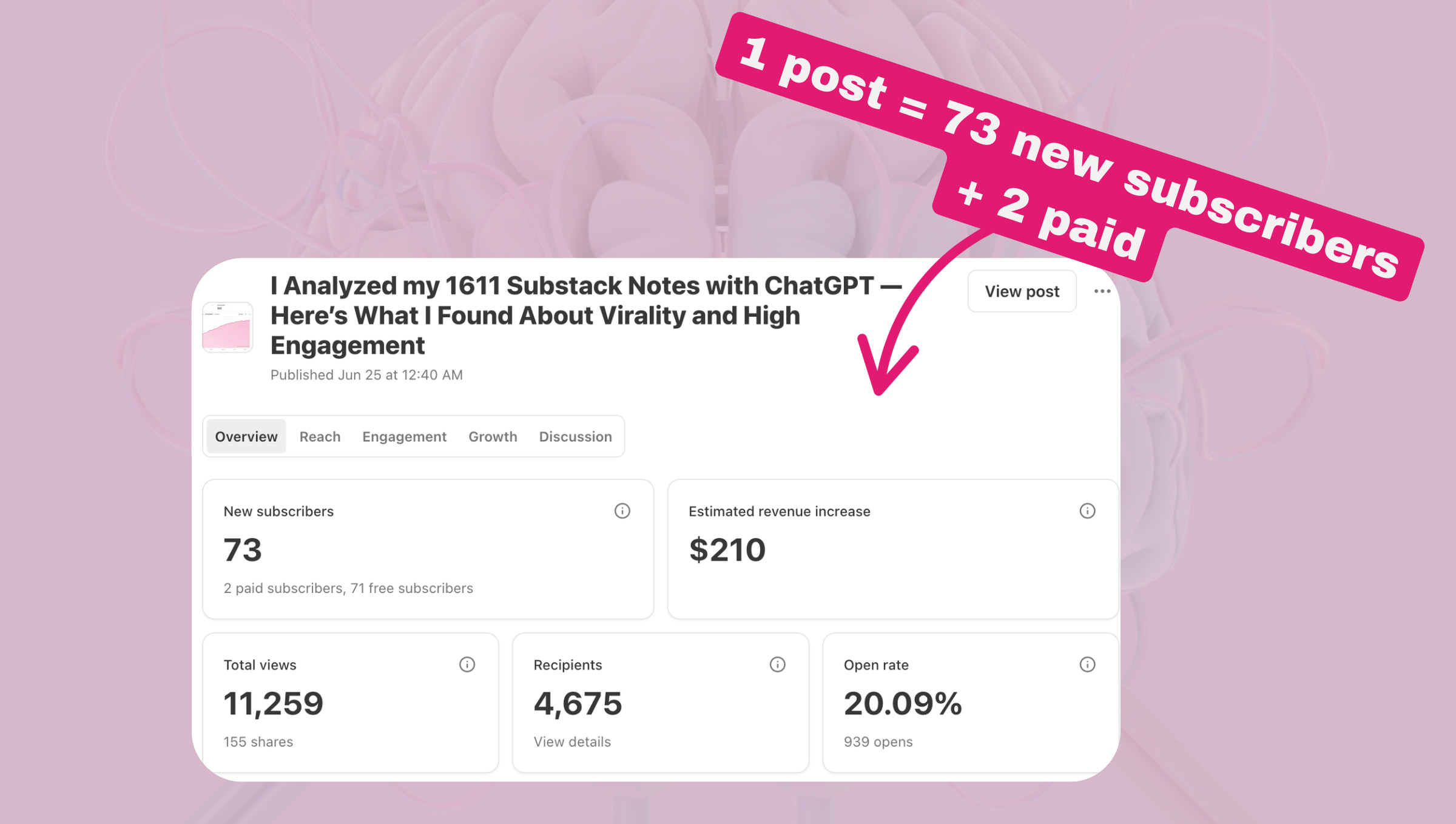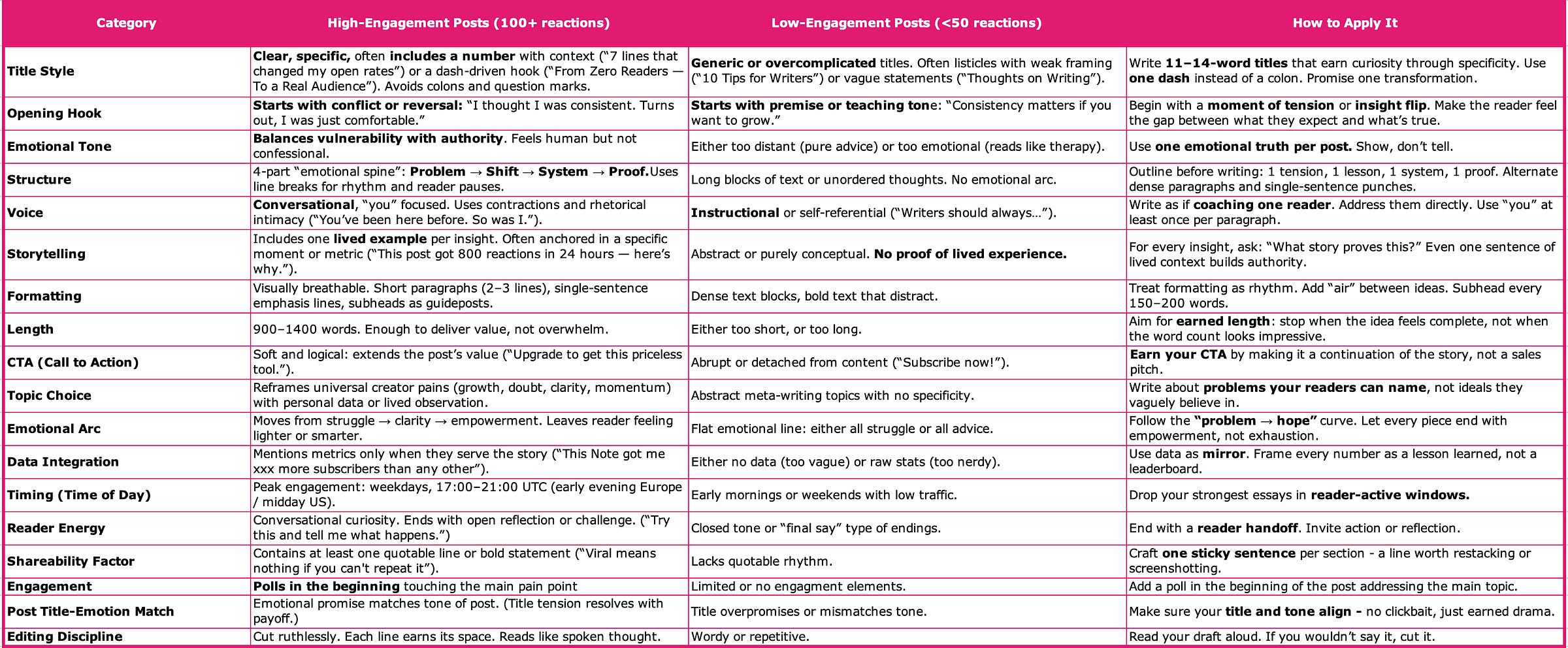I Analyzed 100+ of My Substack Posts with ChatGPT — Here’s What I Learned About Virality and High Engagement
Here’s what actually makes a post go viral on Substack. Writing Viral Substack posts: Analysis & Best Practices
I’ve written a lot of posts that no one cared about, both on Medium and here on Substack.
It’s hard to “keep going” as most gurus say, when you see zero engagement on your heartfelt stories, and virality feels like a lottery. While seeing other much shallower posts getting thousands of likes.
It’s hard…
But Substack is changing. It’s a social media now.
I see posts going viral much like Notes - you get new subscriber notifications coming from “Notes” but when you click - it’s a post.
The only difference: the effect can stay much longer than a viral Note - months not weeks.
So if you struggle with engagement on Notes, try posts.
Now is the best time to try it.
Here’s how.
A few months ago I officially had my first “viral” post on Substack.
More than 500 likes, 73 new subscribers, two of them paid:

I used to think virality of posts was random, a mix of timing, algorithm, and a bit of luck. So I never went deep into it.
Turns out, but it’s not.
After analyzing every single Substack post I’ve written: titles, reactions, word counts, posting times, and all the human signals that drive engagement, the data told a story.
And it’s brutally clear: there are certain elements you can follow to drive high engagement (if not virality).
I went deep into the data: exported my posts, with the help of Finn Tropy’s tools, as always. Selected 100+ from all of my posts, which were relevant for the analysis and uploaded them to ChatGPT (my brand new custom GPT designed for analysis - more on that soon).
I asked it to run a comparative analysis between the posts that got 100+ likes and the ones that flop (less than 20 likes).
The result?
It blew my mind!
It gave me the exact elements I need to have in my posts so that I have higher chances of going viral (and gain more subscribers):
structure and length of titles
best timing to hit publish
number of words
topics
voice
and so much more…
Let’s start with insights from my top 3 posts, which I call “viral” (100+ likes):
Insights from Top 3 Viral Posts
I’ve got three viral posts. Here’s what made them stand out:
The Data-driven curiosity post
The post: “I Analyzed my 1611 Substack Notes with ChatGPT — Here’s What I Found About Virality and High Engagement”
This post combined storytelling with analytics. It used my own data as both a hook and proof, which made it instantly credible. The title promised insight (“here’s what I found”), and the content delivered personal experience through the lens of data exploration.
But it also touched one painful problem, relevant at the time of posting: slow growth.
It also had a poll in the beginning of it, not at the end, which was related to that pain point.
It made people click, which made the algorithm distribute the post wider.
Why it worked:
Readers love seeing creators turn their own experiments into frameworks. The “I analyzed…” format makes it educational and self-revealing. It invited readers into the process instead of teaching from above.
It also benefited from timing and relatability — many Substack writers were struggling with growth, so the theme (“what actually makes things go viral”) hit a shared nerve.
Lesson:
People don’t just want data, they want to know what to do with it. Posts that merge self-discovery with actionable insight perform best.
Trick:
Use a pain point + poll in the beginning.
Downside:
Analytical pieces attract a lot of readers but not always deep subscriber conversions. A lot of people save it for later. I also got a lot of questions which were answered in the post.
To apply this:
Run your own experiment, even a small one, and write it up.
Start with “I tested / analyzed / tracked X for Y days, here’s what I found about Z.”
I actually write this post in the very same pattern, curious how it performs.
The platform trend & practical value post
Post: “Substack Just Released Automated Sequences”
This one exploded because it was immediately useful. And the topic is kind of “sensational” - a long-awaited functionality I just tested and shared first insights.
The structure was crisp: what it means, why it matters, how to use it.
Why it worked:
It delivered real value, fast. Posts that translate platform changes into opportunities perform extremely well because they save readers time. The headline was also clear: no fluff, just “Substack Just Released X.” Straightforward titles build instant trust.
Lesson:
If you can be the first to decode a hot trend or topic for your audience, you’ll own that insight window. The simpler your headline, the broader your reach.
And, again, I had a poll in the beginning addressing the hot topic.
Downside:
Timely posts spike fast but fade fast. Engagement is high, but the lifespan is short once the feature becomes old news. My new subscribers skyrocketed - I got 40 in a day, but then it went back to normal rates of growth.
To apply this:
When a new feature or industry change drops, don’t rush to announce it, rush to test and interpret it.
Write: “Here’s what this means for you.” That’s the difference between being a reporter and being a thought leader.
The transformational personal story
Post: “I Became a Substack Bestseller in Just 3 Months”
This post blended achievement and vulnerability. It celebrated a milestone (“bestseller in 3 months”) but told the human story behind it, how it actually happened, what changed in mindset and process.
Why it worked:
It hit two emotional triggers: aspiration and proof. The milestone gave readers hope, but the story gave it weight. It showed the messy stuff how consistency, experimentation, and burnout led to the badge moment.
It also worked because it was rooted in credibility. The post didn’t brag, just reflected. That balance kept it likable and shareable.
Lesson:
Readers want to see the distance between where they are and where you are, but they’ll only care if you show the steps, not just the results or achievements.
Downside:
Achievement posts can attract admiration but fewer direct conversions, many readers cheer you on, fewer sign up immediately.
To apply this:
When sharing a win, pair every success with the struggle that preceded it.
Example: “I almost quit twice that month. Here’s what made me stay, and what changed everything after.”
The overall pattern
These three viral posts succeeded for three different reasons:
One was data-meets-human insight.
One was timely and actionable.
One was aspirational and emotional.
Together, they reveal a universal truth:
Virality in long-form writing is earned through usefulness, honesty, and transformation.
My key takeaway:
Posts go viral when they either teach through data, translate the moment, or tell a real story that feels like progress. And they all blend with emotional storytelling.
Emotion, timing, and proof: that’s the holy trinity of high engagement.
Important: all of these posts are free. I have viral post from the paid ones, and I definitely have deep stuff there.
Now, the entire analysis and..
What makes a post get high engagement
Here’s the comparative summary of the analysis I made with my new custom GPT:
The Pattern - TL;DR Summary
High engagement = value × emotion × good timing.
Readers don’t share “good writing.” They share usefulness.
Most high engagement posts begin with discomfort and end with a solution to this pain point.
The framework to write high-engagement Substack Posts
Pain: Open with an emotional reversal. “I thought X. Turns out Y.”
Proof: Use a lived story with a number that backs it.
Solution: Extract the solution (not lesson) in plain language.
Actionable: End with one actionable step to solve it.
Engagement: You drive it - add polls, ask questions.
Paid or not: Free posts perform best.
Free newsletters, as a rule of thumb, grow faster in total subscribers. A writer I love reading: Matt Giaro made an experiment for a month, to post every day - post over Notes. It worked well for new subscribers growth. To me this experiment proved this works.
Now, if you have a paid newsletter, like me, make sure you have also enough free posts, which are designed to drive growth.
My viral post proves that it’s possible to leverage this effect even with a paid newsletter.
So no, virality isn’t luck.
It’s by design, built through value, timing, and emotion.
And once I saw that in my own data, I stopped treating “going viral” as luck, and started treating it like a system.
If you’re done guessing what makes your posts take off (and you want a framework that actually works), I break the entire thing down — from content to automation — inside my free masterclass:
→ “How to Build $5K/Month Business Without the Social Media Hustle.”
It’s not theory. It’s the exact system that helped me grow on Substack using AI, automation, and purpose-centric writing.
I see you inside.
Yana
P.S. It’s a hands-on masterclass: you’ll get a FREE Workbook with 5 simple steps to build, launch, sell & automate your first product.




Yana, I look up to you!! Yeah, I know you're not taller than 6'5" 😂 but physical size isn't my point. You continue to show me the way, and I'm getting better at resisting going down rabbit holes.
I'm wondering. What is your self-talk saying today? What's the loudest one say?
What a great breakdown Yana, curious to hear what prompt didy ou give chatgpt to analyse your posts?